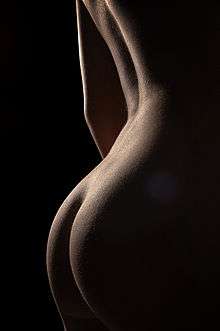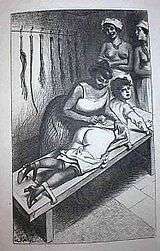Cultural history of the buttocks
Sexualization of the buttocks, especially of the female gender, has occurred throughout history.[1]


Evolutionary significance
Sexologist Alfred Kinsey suggested that the buttocks is the primary sexual presentation site in primates. Some anthropologists and sociobiologists believe that breast fetishism derives from the breasts' similarity to buttocks, but instead provide sexual attraction from the front of the body.[2]
In humans, females generally have more round and voluptuous buttocks, caused by estrogen that encourages the body to store fat in the buttocks, hips, and thighs. Testosterone discourages fat storage in these areas. The buttocks in human females thus contain more adipose tissue than in males, especially after puberty. Evolutionary psychologists suggest that rounded buttocks may have evolved as a desirable trait because they provide a visual indication of the woman's youth and fertility. They signal the presence of estrogen and the presence of sufficient fat stores for pregnancy and lactation. Additionally, the buttocks give an indication of the shape and size of the pelvis, which impacts reproductive capability. Since development and pronunciation of the buttocks begins at menarche and declines with age, full buttocks are also a symbol of youth.[1]
Biological anthropologist Helen B. Fisher said that "perhaps, the fleshy, rounded buttocks attracted males during rear-entry intercourse".[3] In a recent study, using 3D models and eye-tracking technology Fisher's claim was tested and was shown that the slight thrusting out of a woman's back influence how attractive others perceive her to be and captures the gaze of both men and women.[4] [5] Bobbi S. Low et al. said that the female buttocks "evolved in the context of females competing for the attention and parental commitment of powerful resource-controlling males" as an "honest display of fat reserves" that could not be confused with another type of tissue, although T. M. Caro rejected that as being a necessary conclusion, stating that female fatty deposits on the hips improve individual fitness of the female, regardless of sexual selection.[6]
History


The female buttocks have been a symbol of fertility and beauty since early human history. Statues created as early as 24,000 BC, such as the Venus of Willendorf, have exaggerated buttocks, hips, and thighs.[1]
The erotic beauty of the female buttocks was important to the ancient Greeks, thought to have built such statues as Venus Kallipygos (although only a possible Roman copy survives), that emphasize the buttocks.[7] Bare buttocks were also considered erotic in Ming China, where they were often compared to the bright full moon.[8] Many artists pose models to emphasize the buttocks.[7] 19th Century Europeans sought to profit from this unique feature of African women through objectification and exploitation by placing Saartjie Baartman on display in a Human zoo.
The buttocks have been considered an erogenous zone in Western thought for centuries; the eroticization of the female buttocks was heteronormative due to their association and closeness to the female reproductive organs. The buttocks are often taboo due to their proximity to the anus and association with the excretory system. The psychoanalyst Sigmund Freud theorized that psychosexual development occurred in three stages—oral, anal, and genital—and that fixation in the anal stage caused anal retentiveness and a lasting focus on eroticization of the anus.[1]
Erotic spanking was popular in Victorian Britain, perhaps due to the buttocks' fetishization and eroticization. Spanking was prominent in pornography during this time, with erotica such as Lady Bumtickler's Revels and Exhibition of Female Flagellants being consumed.
In Studies in the Psychology of Sex, published in 1927 and written by British physician and sexual psychologist Havelock Ellis, he describes cultural sexual characteristics of the buttocks.[1] He says:
Thus we find, among most of the peoples of Europe, Asia, and Africa, the chief continents of the world, that the large hips and buttocks of women are commonly regarded as an important feature of beauty. This secondary sexual character represents the most decided structural deviation of the feminine type from the masculine, a deviation demanded by the reproductive function of women, and in the admiration it arouses sexual selection is thus working in a line with natural selection.
He adds that
The European artist frequently seeks to attenuate rather than accentuate the protuberant lines of the feminine hips, and it is noteworthy that the Japanese also regard small hips as beautiful. Nearly everywhere else large hips and buttocks are regarded as a mark of beauty, and the average man is of this opinion even in the most æsthetic countries.
Ellis also claims that corsets and bustles are meant to emphasize the buttocks.[9]
Emphasis on the female buttocks as a sexual characteristic has increased in recent times according to Ray B. Browne, who attributes the change to the popularization of denim jeans:
[E]mphasis on the upper female torso has recently given way to the lower area of the body, specifically the buttocks. Such a change happened quite recently when denim jeans became fashionable. In order to emphasize fit, jeans manufacturers accentuated hips. And after brand name jeans became so popular with the designer's name on the hip pocket, even more accentuation was given to the posterior. The more jeans sales increased, the more ads were used which emphasized the derriere, to such an extent, in fact, that this particular area may eventually surpass breasts as the number one sexual image of the female body.[10]
Males
_-_n._1610.jpg)
While female buttocks are often eroticized in heterosexual erotica, men's buttocks are considered erogenous by many women, and are also eroticized in male homosexuality which often centres on anal intercourse.[11][12]
In popular culture
Numerous songs have also been about the desirability of buttocks:
- "Shake Your Moneymaker" (1961)
- "Tush" (1975)
- "(Shake, Shake, Shake) Shake Your Booty" (1976)[13]
- "Fat Bottomed Girls" (1978)
- "Da Butt" (1988)
- "Baby Got Back" (1992)
- "Rump Shaker" (1992)
- "Back That Thang Up" (1999)
- "Thong Song" (1999)[14]
- "I See You Baby (Shakin' That Ass)" (1999)
- "Shake Ya Ass" (2000)
- "Bootylicious" (2001)
- "Salt Shaker" (2003)
- "Shake Ya Tailfeather" (2003)
- "Ass Like That" (2004)
- "Swing" (2005)
- "Check on It" (2005)
- "Honky Tonk Badonkadonk" (2005)
- "My Humps" (2005)
- "Shake That" (2006)
- "Dance (A$$)" (2011)
- "Bubble Butt" (2013)[15]
- "Wiggle" (2014)
- "Anaconda" (2014)
- "Booty" (2014)
Since the early 2000s, songs about the female buttocks have proliferated, especially in the hip-hop, reggae/dancehall, and R&B genres.[1]
Fetishism
A buttocks fetish or buttocks partialism refers to a condition wherein the buttocks becomes a primary focus of sexual attention.[16] It may be associated with coprophilia, panty fetishism, eproctophilia, and sadomasochistic corporal punishment involving the buttocks.[17] Pygophilia refers to sexual arousal caused by the buttocks.[18]
See also
References
- Singleton, Alena J. (2008). "Cultural History of the Buttocks". In Pitts-Taylor, Victoria (ed.). Cultural Encyclopedia of the Body. ABC-CLIO/Greenwood. ISBN 978-0-313-34145-8.
- Slade, Joseph W. (2001). Pornography and sexual representation: a reference guide. Greenwood Press. pp. 404–405.
- Fisher, Helen E. (1982). The Sex Contract: The Evolution of Human Behavior. New York: William Morrow & Company, Inc.
- Elizabeth Hawkins (Oct 25, 2017). "Why arched backs are attractive". springer.com.
- Pazhoohi, F.; Doyle, J.F.; Macedo, A.F.; Arantes, J. (2017). "Arching the Back (Lumbar Curvature) as a Female Sexual Proceptivity Signal: an Eye-Tracking Study". Evolutionary Psychological Science: 1–8. doi:10.1007/s40806-017-0123-7.
- Caro, T.M.; Sellen, D. W. (1990). "The Reproductive Advantages of Fat in Women" (PDF). Ethology and Sociobiology. 11 (5): 1–66. doi:10.1016/0162-3095(90)90005-q.
- Morris, Desmond (1985). Bodywatching: A Field Guide to the Human Species. p. 198.
- van Gulik, Robert Hans (2004). Erotic colour prints of the Ming period: with an essay on Chinese sex life from the Han to the Chʼing Dynasty, B.C. 206-A.D. 1644. p. 223.
- Ellis, Havelock (1927). – via Wikisource.
- Browne, Ray B. (1982). Objects of Special Devotion: Fetishes and Fetishism in Popular Culture. p. 111.
- Cultural Encyclopedia of the Body, page 61.
- Anal Pleasure & Health: A Guide for Men, Women and Couples, Jack Morin, Jack Morin Ph. D. Down There Press, 2010.
- "KC & The Sunshine Band Shake Your Booty Lyrics". Genius. Retrieved 31 August 2015.
- Riordan, Teresa (26 September 2007). "Oh, That Darling Derrière". Slate. Retrieved 7 August 2011.
- "Bubble Butt - 2 Chainz, Black M, Ensi, Major Lazer, Bruno Mars, Tyga - Songs, Reviews, Credits, Awards - AllMusic". AllMusic. Retrieved 20 November 2014.
- Browne, Ray B. (1982). Objects of Special Devotion: Fetishes and Fetishism in Popular Culture. pp. 35–36.
- Steele, Valerie (1997). Fetish: Fashion, Sex and Power. Oxford University Press. p. 124.
- Hickey, Eric W. (2006). Sex crimes and paraphilia. Pearson Education. p. 84.
External links
